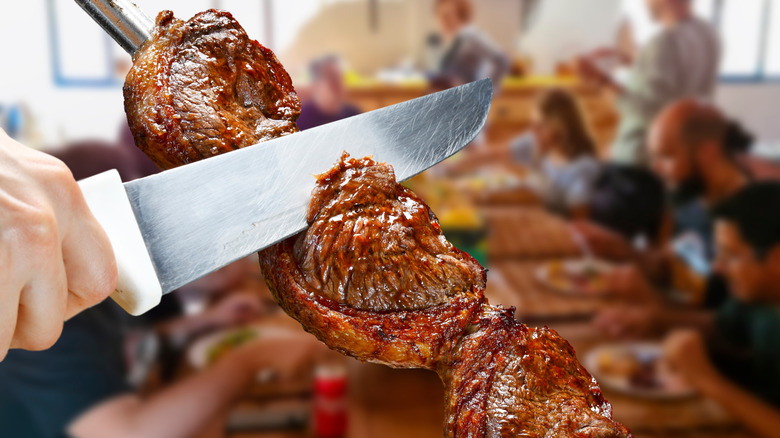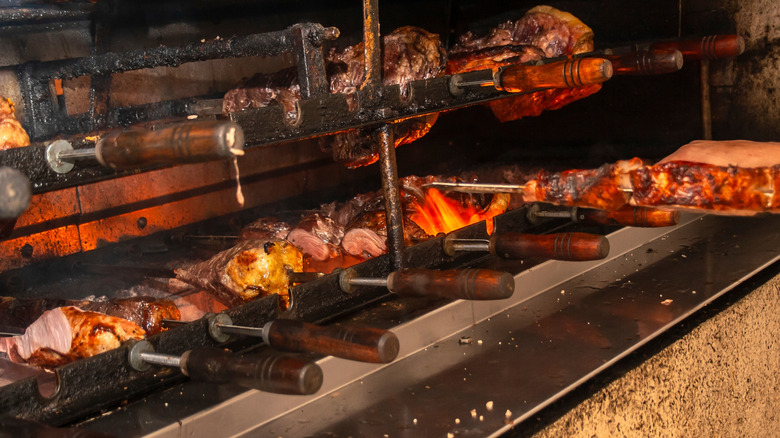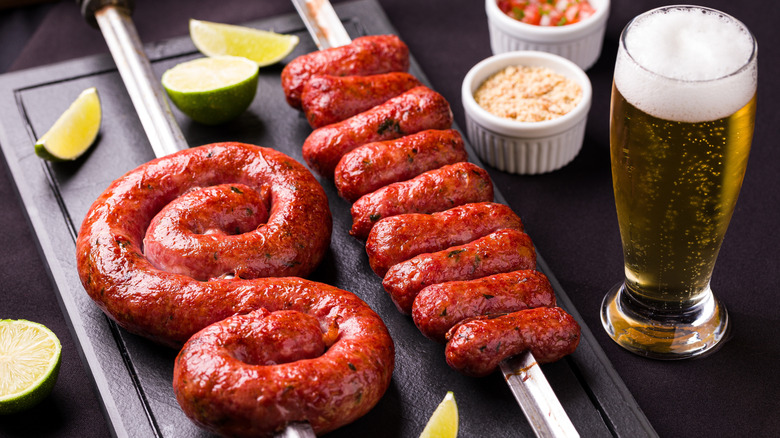What Is A Brazilian Steakhouse And How Does It Compare To American Ones?
Brazilian steakhouses have risen in popularity in recent years, exemplified by the success and expansion of restaurants like Fogo de Chão — and it's easy to see why. A room full of meat perfectly cooked over an open flame, all brought tableside for serving — what could be better than that? For those considering their first dalliance with a churrascaria, you may wonder what sets them apart from their American counterparts.
The first difference you'll notice is the presentation. Brazilian steakhouses are typically staffed by servers called passadores, who serve meat in the rodizio, or "rotation," style. This involves skewers of juicy meat, seasoned with sal grosso (rock salt), carried from table to table and carved tableside for guests. Diners signal their readiness for another round of skewers by flipping a token to the appropriate color: green means "more meat, please!" while red means "I couldn't eat another bite ... until the next round."
While favorites like filet mignon and tomahawk steaks abound, picanha — a Brazilian steak identifiable by its large fat cap — is the real prize. This cut boasts a rich sirloin flavor and a buttery texture that melts in your mouth, thanks to the fat. Another cut that may be unfamiliar to American diners is cupim, which comes from the hump of a zebu, a Brazilian type of cow not generally raised in the United States. Cupim has a uniquely rich and fatty texture.
History of the churrascaria
The origins of Brazilian barbecue trace back to Rio Grande do Sul in the late 17th century. Long before national borders were established, the people in this area of what is now southern Brazil raised and transported cattle, becoming the South American equivalent of cowboys. During this time, these gauchos created a new style of cooking for themselves and their communities.
Constantly on the move, they needed a practical way to prepare food. They would season meats with sal grosso and cook them slowly on swords over open fires, then let them sit to allow as much of the salt to permeate the meat as possible.
This method wasn't limited to everyday meals; it was also used during celebrations when gauchos returned from long cattle drives. By the 1930s, as the rodizio style of service developed, the swords were replaced by large skewers — though the knives wielded by the friendly gauchos coming to cut your meat may still bear some passing resemblance to a blade fit for battle.
How to maximize your Brazilian steakhouse experience
The first visit to a Brazilian steakhouse can feel overwhelming. The bustling gauchos, the spitting fires of the grill, and the large, vibrant salad bar can be as disorienting as a Sunday trip into the depths of Ikea. But keeping a few simple tips in mind will help you get the most out of your experience (and your money).
Try the Brazilian sides, but keep the portions small. While saving room for all that meat is important, if you're new to the cuisine, don't be afraid to carve out a little space for dishes you've never tried. Pão de queijo, a baked cheesy bread, and farofa, a toasted cassava that can be sprinkled on meat or eaten as is, are two sides you're unlikely to find elsewhere, and both can be enjoyed in moderation. If you're lucky, your churrascaria will have feijoada, a hearty black bean and pork stew considered one of the most influential international dishes in the world. Again, take a few bites and move on.
Salad might feel like a necessary counterbalance to all that meat, but remember, you can have a plate of lettuce anywhere, including at home for a fraction of the cost. French fries, mashed potatoes, and other familiar dishes like bacon-wrapped chicken and even cuts of steak like ribeye are foods best skipped at a Brazilian steakhouse in favor of filling up on more uniquely regional cuts.



